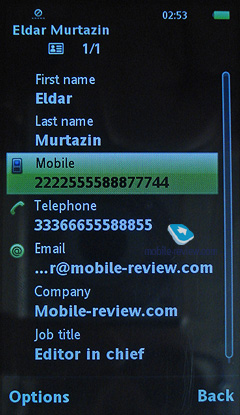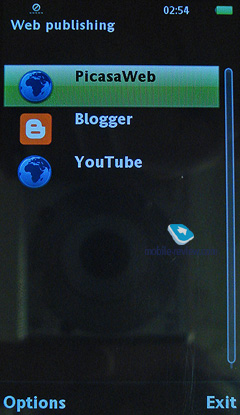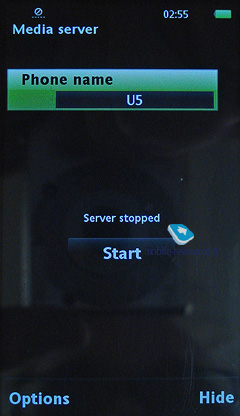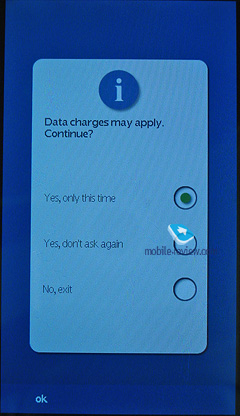|
|
First look at Sony Ericsson Vivaz U5i (Kurara)
This model’s development commenced at around the same time with the Satio (or “IDOU”, its original codename). Over at Sony Ericsson they never thought they’d manage beat their competitors to the market, and they didn’t – the Samsung i8910 HD has been around for a while now and has seen some decent success already. So, what can Sony Ericsson bring to the table to beat Samsung technology-wise? Basically, nothing. The Kukara offers a similar display, yet with worse image quality, since it doesn’t boast AMOLED technology, nor does it offer a huge amount of bundled storage space. Although there is one area where it excels and that’s UI, for it’s the fastest Symbian-based smartphone to date, based on Cortex A8 with 256 Mb RAM. However it’s impossible to see this feat on pictures, and there is not much else going for the Kukara on other fronts. This prompts the question why it has to come out in February or early March, when the Samsung i8910 HD will have already spent around six months on the market by then? In this case the pricing issue moves to the front – at this point, it’s said the Kukara will retail for 400 Euro at the minimum, which is simply too much for a product of this caliber. If it hits the market at this price point, it won’t have even a chance to make any sort of impact. Plus, given the fact that by then the Nokia X6 will be available without Comes With Music and the i8910 HD’s price will dip even lower, leaving only a pretty narrow niche for the Kukara. This fact is well-understood by everyone bar the company’s most loyal fans, who can’t stop bragging about the technological marvel their favorite is about to roll out. They say that’s it's all in the timing, but oftentimes pricing policy is just as important. The U5’s production cost hovers at around 200 Euro, so by forgoing their lust for extra-high margins and opting to retail it for 300 Euro (without contract), they’d be able to turn it into a milestone device and a true icon for its segment. In a way, it’d be more like the Sony Ericsson T610/K750 that shined on the market several years ago. Which route will they pick? We’ll see in a couple of months. At present there is a group of pragmatics over at Sony Ericsson who are struggling to deliver their message that the Kukara won’t have any substantial sales at this price tag, since Sony Ericsson’s brand has lost most of its value in the average consumer’s eyes. The most glaring example in Sony Ericsson’s recent history related to this sad fact is the fate of the Sony Ericsson G700/G900, that boasted terrific price/quality ratios, however never managed to occupy a significant market share. The pragmatics also insist that Sony Ericsson show throw all their resources at Android, for this OS allows implementing all ideas they have and getting the best possible products on the other end, while the Satio’s sales are so miniscule that its successors won’t stand a chance against the competition. In fact, this group of people is comprised of the vast majority of Sony Ericsson’s employees, including people, who buried UIQ. So, perhaps, for them this is initiative is a way to show their disapproval of Symbian on the whole. Judging from Sony Ericsson’s roadmap, they’ve got five Symbian-based phones in development, two of which will definitely see release, while the fate of other three isn’t as certain – they might get ditched in favor of some new Android projects.





On the other hand, the group of Symbian supporters is losing its weight within Sony Ericsson. Why? The reason lies in the Satio’s “success” as a product – and I’m not even going to touch upon its technological merits and countless drawbacks. It was a PR-oriented project from the very beginning and was never meant to become a milestone. But apart from this PR part, inside Sony Ericsson it was positioned as the “right” solution for generating profit and sales volume. By “volume” here we mean not millions or even hundreds of thousands of units, but rather a certain niche. However even within that niche the Satio failed to live up to the company’s expectations. What conclusions have been made? Now Sony Ericsson consider Symbian to their weak spot and if their upcoming phones won’t be able to turn things around, they’ll most certainly dump it.

However is it possible to assess any platform’s potential judging by the sales of niche solutions? In my opinion, this is wrong. It’s quite another matter, though, that Sony Ericsson can’t afford to invest into several platforms at a time these days, so they are forced to ditch some. In this case, ditching Symbian is a logical step, as Nokia are moving this platform to the mass-market and it’ll be difficult to put up a good fight in the lower end of the market. In light of this fact, hopping on the Android train is a much more sound decision, although Sony Ericsson shouldn’t expect a bump-less ride here either. All in all, their current situation is quite complicated, hence the uncertainty within Sony Ericsson as to what OS to pick, and whether they should focus on several platforms. At this point in time they seem to favor the idea of running with one single OS. Surprisingly, Motorola’s recent success with the DROID has served as an argument in favor of Android.
Another question that has been bothering me for a while, is why such phones as the Sony Ericsson U5, U7, X10 don’t debut at the end of 2009, even though they are ready for release? While there is an explanation for the X10, since its proprietary software still requires some tweaking, nothing stands in the way of U5 or U7. As it turns out, Sony Ericsson believe that they’ll be able to cut some costs early in 2010, while these phones don’t have a chance to top the Christmas sales charts. All in all, that’s a reasonable approach, however there is one more thing – since they are moving away from the management of service centers and customer care, they need some more time to finish this process.
On balance, we’ve got a pretty grim picture – the pragmatics will definitely win, and there’ll be no more products like the U5 in Sony Ericsson’s portfolio, at least not in its Symbian part. And if they fail to cut its price down to 300 Euro, the U5 will pass unnoticed.





But let’s get back to our first impressions of the U5. While made out of plastic (which is what we have come to expect from Sony Ericsson), it feels pleasant in the hand. The back cover is so thin that sometimes it seems that you’d be able to pierce it with your finger. Yet, it feels quite sturdy and not loose by any means. The phone carries a microSD memory card slot, although there isn’t much bundled memory at all. The display seems to be pretty sensitive, as it’s similar to the one employed in the Satio. On top of that, the U5 boasts a 3.5mm audio jack at the top, as well as a microUSB socket. As far as its battery time is concerned, in our tests it lasted around one day, although we did give it a run for its money there. Its proprietary UI sports a twitter client, and a Satio-esque Facebook app.



The U5’s camera is nothing to write home about, and except for its 720p resolution for video, it’s little to no different from your average cheap 8 MP module, although our sample shots can indicate that better than any words.

 |
 |
| (+) enlarge, 3264x1836, JPEG |
(+) enlarge, 3264x1836, JPEG |
 |
 |
| (+) enlarge, 3264x1836, JPEG |
(+) enlarge, 3264x1836, JPEG |
 |
 |
| (+) enlarge, 3264x1836, JPEG |
(+) enlarge, 3264x1836, JPEG |
 |
 |
| (+) enlarge, 3264x1836, JPEG |
(+) enlarge, 3264x1836, JPEG |
 |
 |
| (+) enlarge, 3264x1836, JPEG |
(+) enlarge, 3264x1836, JPEG |
 |
 |
| (+) enlarge, 3264x1836, JPEG |
(+) enlarge, 3264x1836, JPEG |

Video sample (mp4, 213 mb) >>>
The product doesn’t offer any innovations that can make one open his mouth and say “Wow” – it’s a solid, likable phone, whose fate depends entirely on its price tag. At 300 Euro it’ll be a bestseller, make no mistake about that; however if they opt to charge a premium for the non-existent brand value, it won’t make any impact on the market. All in all, the U5 is a decent phone, but it needs a fitting marketing strategy more than anything else right now.
Eldar Murtazin (eldar@mobile-review.com)
Translated by Oleg Kononosov (oleg.kononosov@mobile-review.com)
Published — 23 November 2009
Have something to add?! Write us... eldar@mobile-review.com
|
News:
[ 31-07 16:21 ]Sir Jony Ive: Apple Isn't In It For The Money
[ 31-07 13:34 ]Video: Nokia Designer Interviews
[ 31-07 13:10 ]RIM To Layoff 3,000 More Employees
[ 30-07 20:59 ]Video: iPhone 5 Housing Shown Off
[ 30-07 19:12 ]Android Fortunes Decline In U.S.
[ 25-07 16:18 ]Why Apple Is Suing Samsung?
[ 25-07 15:53 ]A Few Choice Quotes About Apple ... By Samsung
[ 23-07 20:25 ]Russian iOS Hacker Calls It A Day
[ 23-07 17:40 ]Video: It's Still Not Out, But Galaxy Note 10.1 Gets An Ad
[ 19-07 19:10 ]Another Loss For Nokia: $1 Billion Down In Q2
[ 19-07 17:22 ]British Judge Orders Apple To Run Ads Saying Samsung Did Not Copy Them
[ 19-07 16:57 ]iPhone 5 To Feature Nano-SIM Cards
[ 18-07 14:20 ]What The iPad Could Have Looked Like ...
[ 18-07 13:25 ]App Store Hack Is Still Going Strong Despite Apple's Best Efforts
[ 13-07 12:34 ]Infographic: The (Hypothetical) Sale Of RIM
[ 13-07 11:10 ]Video: iPhone Hacker Makes In-App Purchases Free
[ 12-07 19:50 ]iPhone 5 Images Leak Again
[ 12-07 17:51 ]Android Takes 50%+ Of U.S. And Europe
[ 11-07 16:02 ]Apple Involved In 60% Of Patent Suits
[ 11-07 13:14 ]Video: Kindle Fire Gets A Jelly Bean
Subscribe
|













































